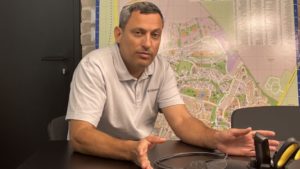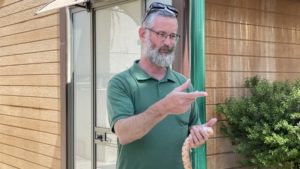Despite the continued threat of rocket and mortar attacks from Gaza, the city of Sderot in Israel’s western Negev is growing, drawing greater commercial investment, and finding new ways to overcome its perennial state of bombardment.
Mayor Alon Davidi told The Media Line that trauma is a constant challenge for the more than 31,000 residents of the city. “The situation in Sderot is not post-trauma, it’s ongoing. It never stops,” he explained.
Yet, according to a survey by the mayor’s office, Sderot’s inhabitants remain unperturbed and continue to live happily on the Gaza frontier.
“When I conduct a poll every year and check how many people would leave the town if they had the chance, most of the people, more than 82%, say that they would stay in Sderot,” said Davidi.
The mayor said much of this comes down to the strong sense of solidarity that life under rocket fire produces among the residents, which is consolidated by each wave of attacks.

The Roklen Resilience Center in Sderot provides trauma counseling to any resident who feels he needs help. (Aron Rosenthal/The Media Line)
“Even though many of us suffer from PTSD, many people find their courage and find that they have abilities within themselves that they did not know they had,” explained Davidi.
Sderot is also extremely well-provisioned to provide trauma counseling to its inhabitants.
When this reporter arrived at the Roklen Resilience Center, painters were busy putting the finishing touches on the lobby.
The state-of-the-art Resilience Center, funded by the National Insurance Institute – Israel’s social security agency, and the Keren Kayement-Jewish National Fund, houses 50 therapists, psychologists and psychiatrists, and provides in-person treatment to any resident of Sderot who wants it.
Ephraim Rosenfeld, an animal-assisted therapist and a local resident, explained that the center is totally inclusive, fully funded, and open to all inhabitants of the city.
“Every person in Sderot who feels he needs help can come here and get help from the Resilience Center,” Rosenfeld said.
“Children get 24 sessions; adults get 12 as a start. If they need more, they get more,” he added.
Davidi said the community is able to fund institutions such as the Resilience Center because of strong financial support from the state.
“We have a big budget, and we work with the government to develop many programs. The government gives us a big budget to bring in psychologists,” he said.
“We have a few projects. One is in the schools; the second is in the community; the third is with the family; the fourth is with the leadership,” continued Davidi.

Sderot Mayor Alon Davidi says that trauma is a constant challenge for the more than 31,000 residents of the city. (Aron Rosenthal/The Media Line)
Today, the existence of the Iron Dome missile defense system makes living in Sderot safer than it was in 2001, when Hamas and Islamic Jihad fired the first Qassam rockets from the Gaza Strip, less than a mile away.
Iron Dome’s protective capabilities are not infallible, successfully intercepting around 90% of Gazan rockets that are headed for populated areas.
Residents are therefore advised to immediately make their way to the nearest bomb shelter upon hearing the warning sirens. They have between 10 seconds and 15 seconds.
While some people have come to ignore the warnings, trusting Iron Dome to protect them, many feel overwhelming fear every time they hear the sirens.
Davidi explained the dire long-term impacts of this fear and trauma, comparing the experiences of Sderot’s inhabitants to that of a typical Israel Defense Forces officer.
“Most of the people [in the city] suffer from PTSD or something. Many times, the post-trauma is very low, but many times it’s very high,” the mayor said.
“If you go to Bahad [training base], the place of the officers in the army, and ask who has been under the attack of mortars or shooting, most of them will say they never have. But if you ask the Davidi family, my family, my seven kids, my neighborhood, they will explain to you how it feels, the feeling that someone wants to kill you,” he said.
Davidi said that for a city like Sderot, shutting down is not an option. Rather, continuing to thrive and to improve the quality of life for its citizens is the most effective way to combat the situation.
“After you understand that this is the reality, that this is the situation, you can start to act. You have two choices with post-trauma. One is to stop and talk with people and go to some treatment. That is good for individuals, but a city must keep going and continue to develop,” he said.

Ephraim Rosenfeld, an animal-assisted therapist and a local resident, who works at the Roklen Resilience Center in Sderot. (Aron Rosenthal/The Media Line)
And develop it most certainly has. Despite the seemingly inhospitable conditions, a number of high-tech firms have offices in Sderot, with employees enjoying tax advantages and companies having access to a large pool of talent from nearby schools such as Sapir College, located just outside town, and Ben-Gurion University of the Negev in Beersheba.
One such firm is Amdocs, a multinational high-tech company founded in Israel in 1982, which specializes in software and services for communications, media and financial service providers and digital enterprises. The firm’s global revenue last year was $4.2 billion.
Yan Davidovsky, the head of software engineering at Amdocs, said that the firm employs 700 people in Sderot, and runs programs at Ben-Gurion University for students, with the goal of eventually recruiting them.
“We are working with academics around Ben-Gurion University. We have a couple of programs running now with the students, and after a certain period we recruit them to join our employees,” he said.
While there may have been government incentives for Amdocs to establish its Sderot office 20 years ago, Davidovsky told The Media Line the company’s decision to continue operating in the city was part of an effort to support the community.
“In general, Amdocs is doing a lot for the population around here. You have many relationships with the community, and one of the reasons for being here is to allow the youngsters to not run away from the city, and from this area,” he said.
If this sounds rather idealistic, Davidovsky emphasized that “this is one of the things which makes Amdocs special,” and that “it’s not only about Israel, and Sderot. This is the view of the company.”

(Aron Rosenthal/The Media Line)
As for the steadily rising population of the city, it does appear that, for whatever reason, people really do want to live here.
The Hesder Yeshiva of Sderot, for example, founded in 1994, is still the largest in all of Israel.
Rabbi Ari Katz, director of public relations for the yeshiva, discussed this surprising phenomenon.
“The city of Sderot today has over 30,000 people, which is an unbelievable number. People don’t realize what that means. A few years ago, if you’d have told people 30,000, they would have thought you were crazy, because of the rockets and everything. People are moving, and they’re building and building and building,” he said.
Aron Rosenthal is a student at the University of Edinburgh and an intern in The Media Line’s Press and Policy Student Program.